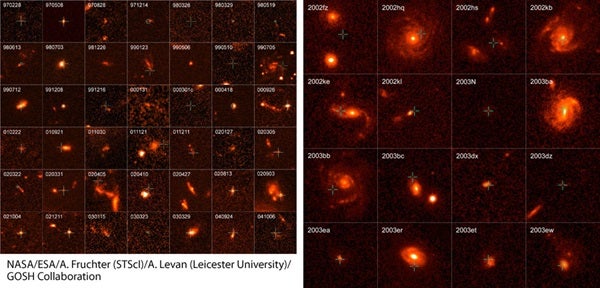Astrophysicists using Hubble Space Telescope (HST) data have determined long-duration gamma-ray bursts (GRBs) and core-collapse supernovae occur in different environments. Scientists believe this type of supernova is related to long GRBs, and this finding may help narrow down why certain core-collapse supernovae evolve into long GRBs.
The group, led by Andrew Fruchter of the Space Telescope Science Institute in Baltimore, studied the locations of 42 well-examined long GRBs (those lasting longer than 2 seconds). The team also looked at 16 core-collapse supernovae (all supernovae are core collapse except type Ia). Supernovae are much more common than GRBs. Because both long GRBs and core-collapse supernovae form when massive stars collapse and explode, scientists expected these objects would occur in the same environment. The group found this isn’t true.
The core-collapse supernovae the group studied are equally divided between spiral and irregular galaxies. Long-GRB host galaxies are small, faint irregular galaxies deficient in metals (what astronomers call elements heavier than helium).
The long GRBs are also located in their hosts’ brightest regions, which implies they form from only the most massive stars — those more than 20 times our Sun’s mass.
The group narrowed the differences down to one key idea: the metallicities of long-GRB hosts are lower than those of galaxies hosting core-collapse supernovae. The oldest stars formed from few metals (mostly only hydrogen and helium), and heavier elements were created in subsequent star generations. Therefore, younger stars have higher metallicities. Because long GRBs likely reside in older galaxies., these long GRBs can be used as tools to study the oldest galaxies, and, hence, the early universe.
In addition, the group’s findings bring good news for those of us on Earth. Only one of the 42 long-GRB host galaxies is a grand-design spiral like the Milky Way Galaxy. This means there’s little likelihood a long GRB will occur in our galaxy. A nearby GRB of this type would cause severe damage to Earth’s atmosphere, climate, and alter genetics.
The group’s result appeared online in Nature May 10, 2006, and will appear in print in a future issue.










